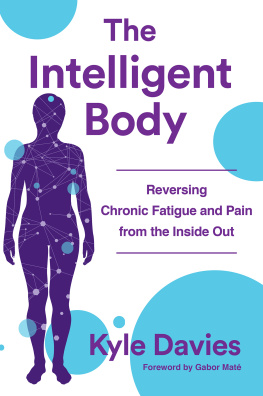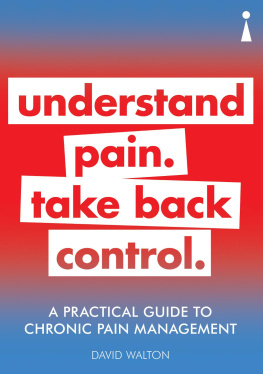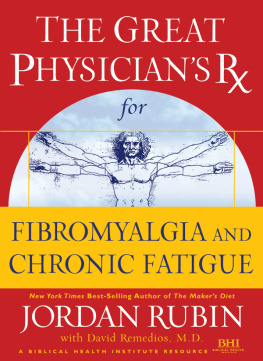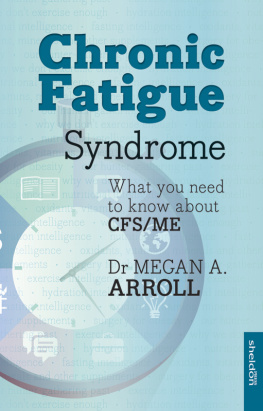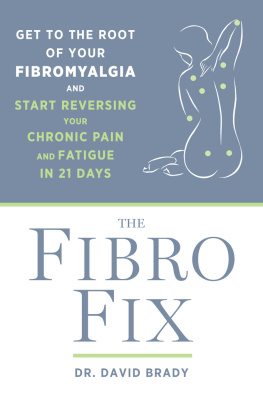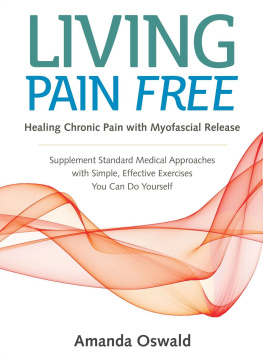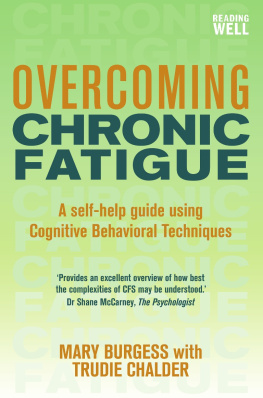
THE
INTELLIGENT
BODY
REVERSING CHRONIC
FATIGUE AND PAIN
FROM THE INSIDE OUT

Kyle Davies
Foreword by Gabor Mat

W.W. NORTON & COMPANY
INDEPENDENT PUBLISHERS SINCE 1923
NEW YORK LONDON
T HE WRITING OF THIS BOOK WOULD NOT BE POSSIBLE IF IT werent for the invaluable and enormous contributions from a whole host of wonderful people. I want to extend my heartfelt gratitude to those people who have supported this work and me over a number of years. These people are, Rebecca Metro, Karen Bate, Nicola Dean, Dr. David Mickel, Dr. Derek Proudlove, Carol Clarke, Peter Haines, Clare Potter, Darryl Williams, Dr. Francis Teeney, Professor Roddy Cowie, Grete Bratberg, Leslee Beckvonpeccoz, Janelle Collard, Alison Lenihan, Maria Whiteley, Steve Rother, John Strydom, Jen Millward, and Paul Hawkins. In different ways these people have had a significant impact on the paths my work and life have taken.
A big thank you goes to all the clients that have chosen to work with me and trust me on their journey back to health. These are the individuals that have played such an enormous role in making this book possible.
I would like to thank Deborah Malmud, Kevin Olsen, Elizabeth Baird, Mariah Eppes, Natasha Senn, Julia Gardiner and everyone at W.W. Norton & Co for giving me the opportunity to write this book and for their on-going patience, guidance, and support.
A special thank-you to Dr. Gabor Mat for his foreword. When I was introduced to Gabors work I was thrilled to see someone else boldly talking about the connection between stress, emotions and disease. His work continues to be an inspiration to me and many others.
Most of all I would like to thank my family for their love and support, particularly my wife Judith, daughters Isabel and Kimberly and my mother Hilary. When I was at school, my intention had been to pursue a career in sound engineering, but chronic tinnitus and the onset of a hearing impairment through the condition otosclerosis, had me rethink that. When looking at what to pursue at university my mother said, why dont you think about psychology, youre good with people, everyone seems to come to you with their problems. That was probably the start of it...

L ET ME CONGRATULATE YOU ON COMPLETING THIS BOOK! IF you have created the time for yourself to try on the theory and play with the exercises, you have done magnificently well! The next step is to begin to practice implementing the principles and practices in your daily life. The more you practice, the more your life will change for the better. It takes a lot of courage to go against the stream of conventional thinking, to do something that challenges you to go deeper to find out who you really are and what you are really capable of. On the surface, many of these ideas may seem quite simple, but implementation can be like peeling away layers of the old programming and conditioning that have clouded your true self.
This book offers a fresh perspective on many aspects of health and well-being, which can take a while to sink in and fully absorb. I frequently have clients say to me that even though theyve heard me say the same things over and over for a period of time, it has taken that time period before they really get it. There is a difference between an intellectual understanding and a deep body appreciation. Being able to fully understand something to the point that it can impact at a deep level and help in creating lasting change can take time and practice. This book is intended to offer more than intellectual stimulation or interest; the intention is that it is the beginning of or a part of your journey of awakening to your true self and experience of health and well-being.
Before you move on from the ideas presented here, I encourage you to work on consolidating what you have learned here first. The thinking mind has a tendency to want novelty, which is not a bad thing, but this tendency can sometimes lead us to miss opportunities that are available to us. So I would suggest that you go through the book several times, and if you feel drawn to it, to include the chapters and exercises you might have skipped through, or to do the ones that you feel you had not given sufficient practice to once again, and even to repeat those that worked for you. You might be surprised how this commitment to finding a deeper view by means of repetition can bring about insights you may have only glimpsed the first time round.
You are also likely to find that completely fresh understandings arise when you repeat your reading and practice of the material. There are so many distractions in our daily lives that it is likely you might have missed some important and helpful details the first time you encountered this information. But be prepared for some resistance to repetition; the thinking mind often wants to move on because it subconsciously knows it has skipped over some details that are threatening to it. So repetition is part of the new courage you are learning. You are becoming more willing to let go of old thinking and habit patterns, and so some resistance will be part of that process. Be gentle with yourself if you sense this resistance, and come back to the material when you feel ready. This book is always at hand, so there is no need to rush. Even if you should move on to other teachings you might find that occasionally you are reminded of something you had encountered here. When that happens, give yourself the gift of returning to this material to immerse yourself in whatever aspect of it feels right for you at that time.
You have the capacity to make a significant difference to your health and the quality of your life. You dont have to continually seek answers outside of yourselfwhat you have read here will guide you back home, back to yourself.
The theory, principles, and practices outlined in this book have been developed over many years and not only have I honed and fine-tuned them with my clients in my clinical practice, I have used and still use them in my own life. Its over to you now; when you make that commitment to yourself and believe in your own ability to heal yourself, you will begin to see and feel yourself take great strides.
Enjoy the journey!
K YLE DAVIES SET HIMSELF NO MODEST TASK IN WRITING The Intelligent Body. The purpose of this book, he asserts, is to guide you back to your true self. As many readers will find, if they apply his reasoning and guidance, the goal is achievable.
Davies approaches his subject with the simple intuitive awarenessarising from his clinical observations and amply documented by modern researchthat mind and body cannot be separated. It follows that emotions help shape physiology. The suppression of emotions or their overindulgent expression may interfere with the healthy physiology of the human organism.
His clients come to him with constellations of symptoms: some non-specific such as headaches or anxiety, others classifiable under various diagnoses such as chronic fatigue syndrome, irritable bowel syndrome, fibromyalgia, or more medically respectable illnesses such as multiple sclerosis. Common to them all is stress the clients themselves have not acknowledged, life histories that have entrained emotional patterns that bespeak separation from gut feelings, identities based on external factors rather than a true valuation of the self, and difficulties regulating or, all too often, even fully experiencing, ones emotions.
Next page
